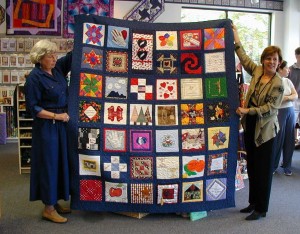
Quilt making was uncommon in America until the early nineteenth century. Most women were busy spinning, weaving and sewing to clothe their family. Only the wealthy had the leisure for quilting. Quilts made during that period were not made of leftover scraps or worn clothing to provide a humble bedcovering for warmth. Instead, quilts of the early 1800’s were whole cloth quilts, and broderie perse, both styles made for beauty, and featuring a generous use of expensive fabrics.
Whole Cloth Quilts featured whole, solid pieces of fabric, in which the quilting stitches became the works of art, including feathers, flowers and other natural motifs. Some were made even more exquisite by a method called trapunto, which is the technique of slipping extra stuffing into certain areas of a quilt to bring out the quilting in that area. For example, trapunto stuffing inside a feather or flower makes that part of the quilt thicker, so the design stands out.
Broderie perse refers to the appliqué of cut out motifs from printed fabric onto a solid background. This form of quilt making has been done since the 18th century. The popular printed fabric during this period was chintz imported from India. Broderie perse bed coverings were usually used on the best bed, or sometimes only when guests were staying in the home.
The industrial revolution brought dramatic changes to the quilting art. Textiles were manufactured on a broad scale and were available to more quilters, who no longer had to spend time spinning and weaving. By the 1940’s, quilt making became widespread. During this period, the Singer Company, in 1856, made the newly invented sewing machine available to more families.
To learn more about the art of quilting, plan to visit the Festival of Quilts, at the Cottonport Museum and Cultural Center, on Saturday, October 2nd, from 9:00am to 3:00pm, and Sunday, October 3rd from 11:00am to 2:00pm. More than 100 beautiful quilts will be on display. Many will be for sale. The quilts will remain on display through October 10th, during regular museum hours, which are 9:00am until 4:00pm on week days. Call for more information about the quilts or the Festival itself at either (318) 876-3797 or (318) 359-3012. The Festival will feature not only wonderful quilts, but delicious home-made cakes and casseroles, as well as other wonderful foods, arts and crafts. The Festival of Quilts is a wonderful family activity, guaranteed to make you feel great!
For more information on Avoyelles Parish contact us at the Avoyelles Commission of Tourism. Write to us at 8592 Highway 1, Suite 3, Mansura LA 71350. Call Mary, Sara, Earline, Marie or Wilbert Carmouche, Tourism Director, at (800) 833-4195, or call us locally at (318) 253-0585; or visit us at www.traelavoyelles.com or e-mail us at [email protected].









